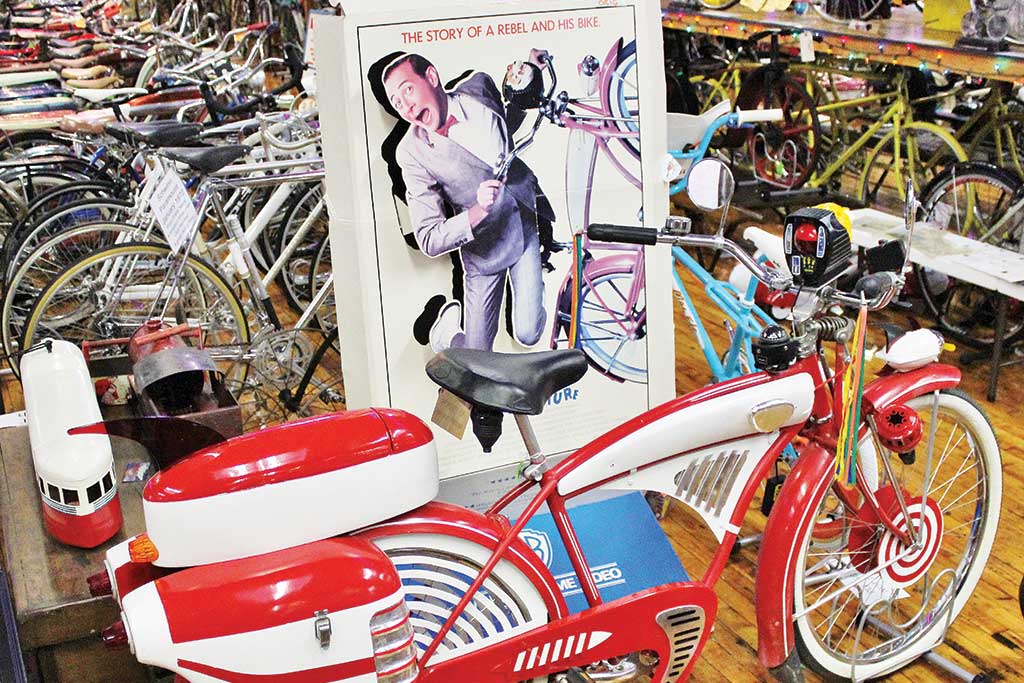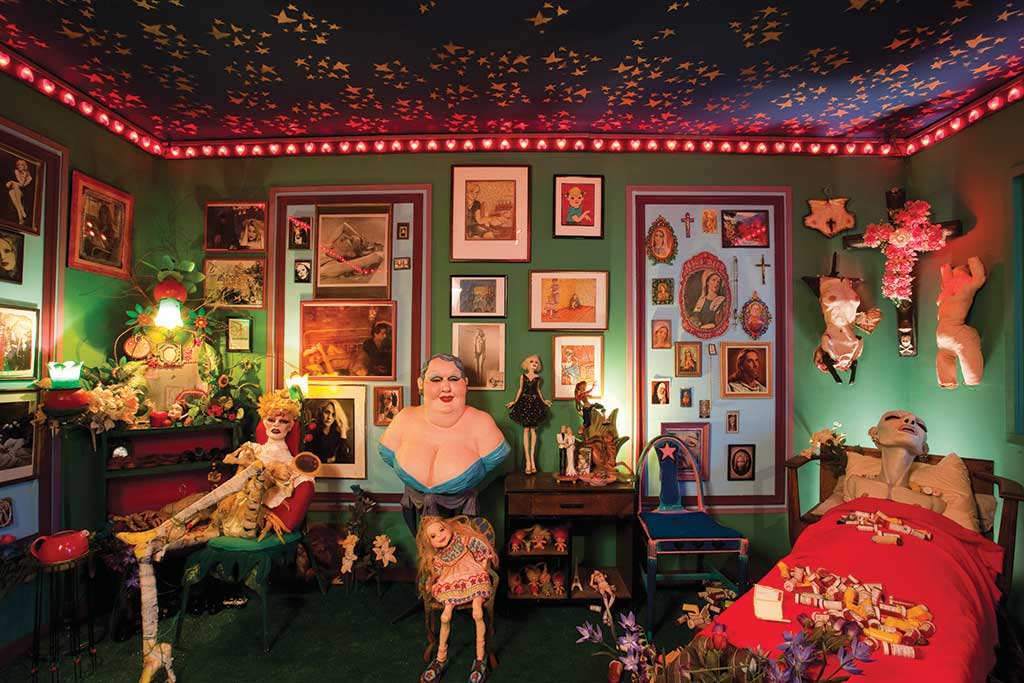One such character is Randy Gilson, another local champion who has bestowed Pittsburgh with a most artful address. Raised poor in Homestead, just east of the city, Gilson faithfully heeded his mother’s advice “to always do good deeds.” That included fixing up neighbors’ gardens for free, which gave the young dreamer a feel for creating shapes and turning blight into beauty. Scavenging abandoned toys for his five siblings at Christmas, he also found purpose in recycling, reuse, and positivity. Known as an “ambassador and fixer,” he’s always willing to help others. From these roots, Gilson, who is gay, blossomed in his quest to transform “waste into wonder.”
In 1978, he moved to the Mexican War Streets neighborhood in Pittsburgh’s historic Central Northside. Named after significant figures and places from the Mexican-American War, the district, renowned for its Victorian-era row houses, had survived threatened demolition in the 1960’s, and in 1975 was listed on the National Register of Historic Places. Yet, it was embattled, rife with unemployment, drugs, and crime. For Gilson, it was an open canvas. Creating the “Old Allegheny Garden Society” in 1982, his beautification efforts began by placing flowerfilled whiskey barrels, or “pop-up nature reserves” around the neighborhood. It attracted a following, and over time, his “people projects by people” produced some 800 barrels, 50 vegetable gardens, eight parks, trees, and more.
In 1995, Gilson and his partner Mac acquired a corner property in the neighborhood for $10,000. “The building, over a century old, had been taken over by squatters and drug users,” he recalls. “With my faith in doing something good, I put down my credit card and got to work.”
The result, Randyland, gloriously personifies Gilson’s mindscape. Rainbow flags, mannequin heads, bicycles, plastic flamingos, planters, toys, and myriad other found objects decorate his freeadmission garden fantasy, surrounded by three gaily painted buildings. Welcome signs in dozens of languages, hand-painted by visitors, cover one wall; the mirrors arrayed on another create a reflective mosaic of changing scenes; couches, chairs, picnic tables, and umbrellas invite leisurely lounging.
Gilson, with his bleached-blond hair and relentless thumbs-up energy, is the master of ceremonies. When not working as a server at the Westin in downtown Pittsburgh, he greets each visitor in turn (which can top 300 some days) with hugs and selfies. “There’s a rule at Randyland,” he announced to the crowd. “If you don’t play, you don’t stay!”

Bicycle Heaven Pee Wee’s Big Adventure credit Jeff Heilman
Featured in the 2015 documentary Pursuing Happiness: The Search for the Happiest People in America, Gilson is all about joy and giving back. As rents rise in the neighborhood, the ironic price of his efforts, he wants to give his self-funded Randyland to the city as a museum and center for the arts.
There is much love for this local hero. Last year, donations poured in to send Gilson and Mac, terminally ill with cancer, to the Grand Canyon and California for a long overdue vacation.
Support also comes from local dreamers and doers like Foo Conner, who helps promote Randyland. If there’s an event in town, Conner, an activistartist-journalist with punk-vagabond spirit, is there. Brian O’Neill called him “the transformational journalist with 93,000 Twitter followers who has codirected Randyland into a selfie mecca.”
Conner and Gilson took me on a short walking tour of the Mexican War Streets, including the former home of George Washington Gale Ferris Jr., and City of Asylum, a community center and refuge for exiled and threatened writers.
Settling afterwards at the Commonplace Coffee Company, Conner opened up about all things Pittsburgh, including referencing Richard Parsakian and this takeaway: “Half the population is gone, but the infrastructure created for Pittsburgh at its height remains behind,” he said. “For artists, that presents a landscape to experiment, or ‘fail forward.’”
With that in mind, my whirlwind twoday drive around Pittsburgh continued, starting with the Northside’s other singular art coordinates.
Close to Randyland is the Mattress Factory Art Museum. The 1977 creation of artist Barbara Luderowski, who relocated to Pittsburgh from Michigan in 1972, this boundary-pushing center of installation art, housed in a converted Stearns & Foster warehouse, is a Pittsburgh must.
From there, I wound down into the Chateau neighborhood, where admission-free Bicycle Heaven, located in a former industrial park by the Ohio River, claims rights as the world’s largest bicycle museum and sales/repair shop. From the Victorian-era Penny Farthing to the bike from Pee-wee’s Big Adventure, founder Craig Morrow’s roughly 4,000-piece collection invites a leisurely spin. The same complex is home to Johnny Angel’s Ginchy Stuff & Music Museum. Lead singer of the Halos (founded in 1966) and still going strong, Angel is one “ginchy” (50’s slang for cool) dude often on hand to share stories amid his Doo Wop, soul, pop, and rock memorabilia.
Sweeping up into the East End’s swirl of neighborhoods, stops included Parsakian’s Shadyside neighborhood, where he identified the Ace Hotel, which supports LGBT events, and in nearby East Liberty, the Kelly Strayhorn Theater, featuring queer programming, as “great partners.”
In Friendship/Garfield, the free-admission Pittsburgh Glass Center offers self-guided tours, hotglass demonstrations, and private workshops. Highland Park, among Pittsburgh’s oldest neighborhoods, is home to Jeffrey Smith Salon, where Smith, another early 1970’s transplant, combines beauty and styling services with jewelry design and art collecting. In affluent Squirrel Hill, the Hidden Harbor tiki bar is great fun.
One of my perennial Pittsburgh pilgrimages is the circa-1893 Phipps Conservatory and Botanical Gardens in Oakland, which today, continues to raise green building technology to a high art form while providing, as it always has, a verdant sanctuary as “the Green Heart of Pittsburgh.”
Just above downtown along the Allegheny River, the mile-long Strip District is a reclaimed industrial neighborhood bustling with restaurants, nightclubs, shops, and food vendors. Diversions run the gamut, from the Smithsonian-affiliated Senator John Heinz History Center to two lively gay draws, Cruze Bar and nearby divey go-go bar, Real Luck Café.
After waiting out a biblical thunderstorm, I repaired to the first of my two downtown hotels, the Fairmont Pittsburgh. Another community ally, the hotel hosts Parsakian’s Ecolution Fashion Show in its sleek lobby as part of the annual citywide “Steel to Sustainable” celebration each spring on Pittsburgh Earth Day.
Yielding some 26,000 items dating from 1840 to 1872, the dig revealed the plot’s past lives as a German boarding house, toy store, and other enterprises. With suites and boardrooms named after these former businesses, the hotel’s museum-style displays of some of the artifacts underscores the property’s “Art and Industry” motif.
The hotel sits in the heart of Pittsburgh’s 14-square-block Cultural District. Seven world-class theaters, including the August Wilson Center, Benedum Center, Cabaret at Theater Square, and Heinz Hall, are surrounded by art galleries and numerous shops and restaurants. Unique draws include the ToonSeum, dedicated to cartoon and comics, and for film buffs, the Harris Theater. Originally the Art Cinema, this 200-seat venue, with its fetching neon marquee, was among Pittsburgh’s first experimental art film houses.


Mattress Factory Greer Lankton, It’s All About ME, Not You credit Mattress Factory
Facing Pittsburgh’s South Side Slopes, my 22nd-floor room at the Fairmont provided its own cinema screen. In the foreground rose PPG Place, Pittsburgh’s skyline-defining glass castle. Clad in nearly one million square feet of reflective glass panels, this five-building complex, dotted with 231 spires, includes a centerpiece 635-foot tower glazed in 19,750 pieces of glass.
Beyond rose Mount Washington, topped by historic neighborhoods and signature panoramic views. At night, the city’s two (of 23) surviving incline railways, the Duquesne and Monongahela, are illuminated in red and green.
Artful, too, was my other hotel, Kimpton Monaco Pittsburgh. Updating a 1903 beaux arts office building, the highlight for me was the hotel’s Commoner restaurant. Running the length of the hotel’s lower level, the 120-seat space features an inviting bar, open kitchen, and industrial-chic accentuated by black-steel columns and etched smoked-glass panels.
So much art, so little time. It all took place within the span of just a couple of days, but journeying into this extra-dimensional hidden valley felt like a much bigger adventure. And there was still much more to see, like the artfully odd, bizarre, and macabre side of Pittsburgh’s creative scene.
Ten minutes from Braddock in Swissvale, Trundle Manor, by appointment only, is headquarters of “The Secret Society of Odd Acquisition,” featuring “years of insane collecting and creating” from curators Mr. Arm and Velda Von Minx.
Adjoining Mount Washington, resurgent Allentown is weirdly wonderful, according to local “Brainsick and Damned” artist Steph Sciullo, whom I met at the Oddities Flea Market in Brooklyn, N.Y. last November. Neighborhood highlights include the Morose & Macabre’s Atrocity Exhibition. Held annually at the Rex Theater, this “cavalcade of the beautiful and grotesque, brought to life by a cabaret of bizarre entertainers, artists, and artisans” is presented by Kelly Macabre Noir and Aaron “Dr.” Morose, who also own the Weeping Glass oddities store. There’s also Onion Maiden, a “punk rock-fueled, heavy metal-spawned” vegan and vegetarian restaurant, and inaugurated last October, the free one-day Le Crème Music and Arts Festival.
And there’s much more to discover as well. Amid the rust and decay, the cultural foundation laid down by Andrew Carnegie, Thomas Mellon, H.J. Heinz, and the city’s other industrialists endures, giving Pittsburgh and its artists perpetual room for discovery and reinvention, and visitors constant reasons to come back.


